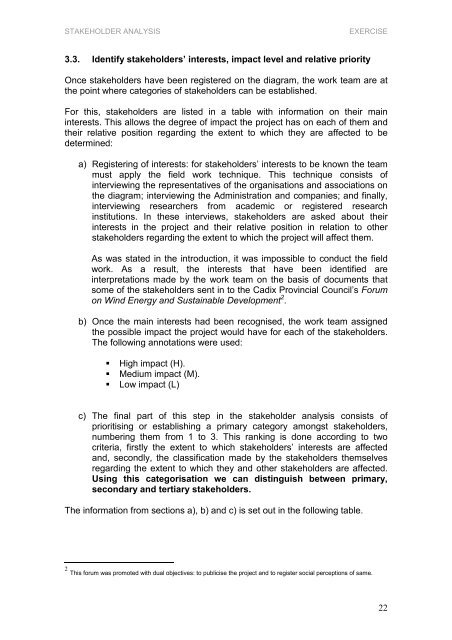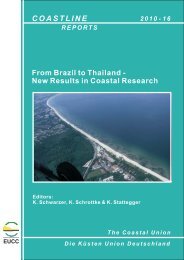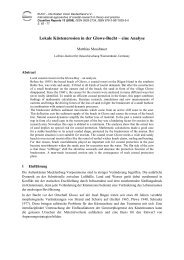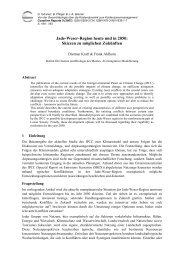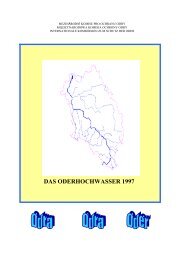An exercise in Stakeholder Analysis for a hypothetical offshore wind ...
An exercise in Stakeholder Analysis for a hypothetical offshore wind ...
An exercise in Stakeholder Analysis for a hypothetical offshore wind ...
Create successful ePaper yourself
Turn your PDF publications into a flip-book with our unique Google optimized e-Paper software.
STAKEHOLDER ANALYSIS EXERCISE<br />
3.3. Identify stakeholders’ <strong>in</strong>terests, impact level and relative priority<br />
Once stakeholders have been registered on the diagram, the work team are at<br />
the po<strong>in</strong>t where categories of stakeholders can be established.<br />
For this, stakeholders are listed <strong>in</strong> a table with <strong>in</strong><strong>for</strong>mation on their ma<strong>in</strong><br />
<strong>in</strong>terests. This allows the degree of impact the project has on each of them and<br />
their relative position regard<strong>in</strong>g the extent to which they are affected to be<br />
determ<strong>in</strong>ed:<br />
a) Register<strong>in</strong>g of <strong>in</strong>terests: <strong>for</strong> stakeholders’ <strong>in</strong>terests to be known the team<br />
must apply the field work technique. This technique consists of<br />
<strong>in</strong>terview<strong>in</strong>g the representatives of the organisations and associations on<br />
the diagram; <strong>in</strong>terview<strong>in</strong>g the Adm<strong>in</strong>istration and companies; and f<strong>in</strong>ally,<br />
<strong>in</strong>terview<strong>in</strong>g researchers from academic or registered research<br />
<strong>in</strong>stitutions. In these <strong>in</strong>terviews, stakeholders are asked about their<br />
<strong>in</strong>terests <strong>in</strong> the project and their relative position <strong>in</strong> relation to other<br />
stakeholders regard<strong>in</strong>g the extent to which the project will affect them.<br />
As was stated <strong>in</strong> the <strong>in</strong>troduction, it was impossible to conduct the field<br />
work. As a result, the <strong>in</strong>terests that have been identified are<br />
<strong>in</strong>terpretations made by the work team on the basis of documents that<br />
some of the stakeholders sent <strong>in</strong> to the Cadix Prov<strong>in</strong>cial Council’s Forum<br />
on W<strong>in</strong>d Energy and Susta<strong>in</strong>able Development 2 .<br />
b) Once the ma<strong>in</strong> <strong>in</strong>terests had been recognised, the work team assigned<br />
the possible impact the project would have <strong>for</strong> each of the stakeholders.<br />
The follow<strong>in</strong>g annotations were used:<br />
� High impact (H).<br />
� Medium impact (M).<br />
� Low impact (L)<br />
c) The f<strong>in</strong>al part of this step <strong>in</strong> the stakeholder analysis consists of<br />
prioritis<strong>in</strong>g or establish<strong>in</strong>g a primary category amongst stakeholders,<br />
number<strong>in</strong>g them from 1 to 3. This rank<strong>in</strong>g is done accord<strong>in</strong>g to two<br />
criteria, firstly the extent to which stakeholders’ <strong>in</strong>terests are affected<br />
and, secondly, the classification made by the stakeholders themselves<br />
regard<strong>in</strong>g the extent to which they and other stakeholders are affected.<br />
Us<strong>in</strong>g this categorisation we can dist<strong>in</strong>guish between primary,<br />
secondary and tertiary stakeholders.<br />
The <strong>in</strong><strong>for</strong>mation from sections a), b) and c) is set out <strong>in</strong> the follow<strong>in</strong>g table.<br />
2 This <strong>for</strong>um was promoted with dual objectives: to publicise the project and to register social perceptions of same.<br />
22


